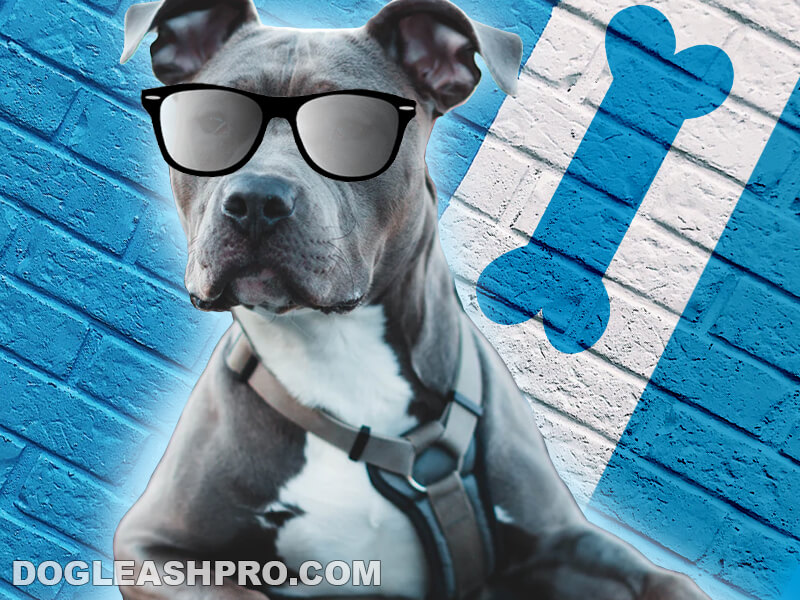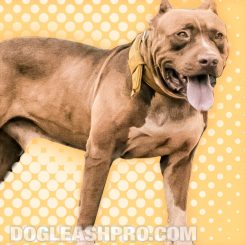
You’re probably interested in the Blue Nose Pitbull or you’re wondering if the Pitbull you have is a Blue Nose which is why you’ve landed on this article. Before you decide to adopt a Blue Nose Pitbull from your local shelter or buy one, you want to know how much Pitbulls shed, why they are called Blue Nose, whether they will get along with your family members, and more!
In this comprehensive article, we’ll cover what a Blue Nose Pitbull is, their size and height, temperament, personality, and whether Blue Nose Pitbull is right for you. We’ll also share some of the health problems they are susceptible to. Lastly, we’ll provide you with 20 facts about the Blue Nose Pitbull.
Table of Contents
What is a Blue Nose Pitbull?
Blue Nose Pitbulls are a rare color variant of the American Pit Bull terrier. They are not a distinct breed, and their differences from the usual black nose Pit Bulls are just skin-deep.
These Blue Nose Pitbull dogs are muscular, stocky, and powerful. The only difference is their nose, which is a lighter shade of black. They have the same coat as other Pit Bulls, but Blue Nose Pitbulls sometimes have a diluted black coat.
Blue Nose Pitbull: Why Do They Have a Blue Nose?
The bluish-grey or diluted black color of the Blue Nose Pitbull comes from a gene called eumelanin. This gene sometimes affects the coat color and can also give the Pit Bull blue eyes. It’s a recessive gene, so it often gets taken over by the dominant regular black nose gene.
Check out: White Pitbulls (Complete Guide)
History of the Blue Nose Pitbull
Breeders have always tried making dogs with unique physical features. The Blue Nose likely developed by accident while some breeders were trying to breed a blue-coated American Pit Bull terrier.
What Color Coat Does a Blue Nose Pitbull Have?
A Blue Nose Pitbull can have a silver or diluted black coat, but they often come in standard Pitbull coat colors like fawn, white, grey, and brown.
Don’t miss: Grey Pitbull (Complete Guide)
Blue Nose Pitbull size
Blue Nose Pitbulls are American Pit Bull terriers, and they have been selectively bred for size. Their bodies are much larger than their small bulldog and terrier ancestors, which brings us to the question:
How big do Blue Nose Pitbulls get?

Blue Nose Pitbulls grow 17 to 24 inches in height. It puts them among medium-to-large dogs; however, they think of themselves as babies. A Blue Nose Pitbull loves being carried and would often snuggle beside its owners or human family members.
Blue Nose Pitbull weight
As with most mammals, a male Blue Nose Pitbull weighs slightly more than a lady Blue Nose Pitbull. While males can weigh about 50 to 65 pounds, females grow no heavier than 50 pounds. The minimum weight of a healthy and purebred Blue Nose Pitbull is 30 pounds.
8 week old Blue Nose Pitbull
There is no size disparity between male and female Blue Nose Pitbulls at this age, and all Blue Nose Pitbull puppies weigh 5 to 15 pounds.
3 month old Blue Nose Pitbull
The size disparity is still absent, and both the male and female Blue Nose Pitbull pups weigh 10 to 20 pounds.
4 month old Blue Nose Pitbull
Male Blue Nose Pitbulls grow a little faster, weighing 15 to 25 pounds compared to the 10 to 20 pounds weight of a female Blue Nose Pitbull of the same age.
6 month old Blue Nose Pitbull
Male Blue Nose Pitbulls weigh 20 to 35 pounds and female Blue Nose Pitbulls weigh 15 to 30 pounds. Blue Nose Pitbulls experience rapid growth during this age.
1 year old Blue Nose Pitbull
Male Blue Nose Pitbulls weigh 30 to 55 pounds and female Blue Nose Pitbulls weigh 25 to 45 pounds. Their height can reach 1.5 to 2 feet. Pit Bulls continue growing at a slow rate after this.
Blue Nose Pitbull temperament
Blue Nose Pitbulls are tremendously friendly, and even an untrained Blue Nose Pitbull dog welcomes human company.
However, they don’t extend this hospitality to other dogs and animals. Due to their ancestral habits, they require early socialization and training in order to mingle with other animals.
Read also: Gotti Pitbull (Complete Guide)
Blue Nose Pitbull personality
Blue Nose Pitbulls are big softies despite their scary appearance. They crave human attention and would do anything to please their human owners.
These Pit Bulls are also caring, affectionate, wise, and gentle. They are so good with children that they were used as nanny dogs for a long time in England.
How long do Blue Nose Pitbulls live?
A Blue Nose Pitbull free from congenital disabilities and treated, fed, and exercised correctly can easily live for 12 to 15 years.
Related Article: Pitbull Lifespan (How Long Do Pit Bulls Live?)
Blue Nose Pitbull facts: 20 Facts!
1. Blue Nose Pitbulls are not a separate breed
Blue Nose Pitbulls are a color variation of the American Pit Bull Terrier and not a separate breed. A rare genetic mutation gave them their Blue Noses. The blue also shows in the dog’s coat and eyes.
If you take your Blue Nose Pitbulls outside under the bright sun, you’ll be able to clearly see the blue color of their eyes, coat, and nose!
2. Blue Nose Pitbulls descend from bulldogs and terriers
Bulldogs are strong and tenacious; terriers are fearless and agile. The old European bull baiters bred those two together to produce the Pit Bull terrier.
3. They have an unfair reputation due to their past
Nowadays, Pitbulls get a bad reputation for being aggressive due to their past. However, when raised correctly, Pitbulls are not aggressive. Instead, they love people and love being around people.
Oftentimes, they will jump up on strangers as a way to greet them or ask for a hug and many will take this the wrong way seeing that a large dog has jumped up on them. Many will react by being scared or running away.
Fun Fact: Many dog owners trust having Pitbulls around their babies. But, are Pitbulls safe around babies? Check out Pitbulls And Babies to find out!
4. Blue Nose Pitbulls don’t gel with other animals
Blue Nose Pitbulls get along great with humans but not other animals. It dates back to their sports history. Although they will keep your house free from unwanted vermin, don’t expect them to gel with other pets.
5. Blue Nose Pitbulls can lose the blue
In some cases, a Blue Nose Pitbull puppy loses its blue coloring as it grows. That can be frustrating for owners who paid a premium for a rare Blue Nose Pitbull puppy.
6. Blue Nose Pitbulls make poor guard dogs
Blue Nose Pitbulls are big softies. They love people so much that they don’t mind getting pets from strangers. As you can guess, that makes them awful guard dogs.
7. Blue Nose Pitbulls’ appearance comes from a recessive gene
The Blue Nose gene is recessive and hardly ever occurs naturally. For a Pitbull puppy to be born blue-nosed, both its parents should be Blue Nose Pitbulls. There are some exceptions, though; we’ll discuss them next.
8. A Blue Nose Pitbull can come from a non-blue parent
In some cases, a Pitbull puppy can be Blue-Nosed even if just one of the parents was Blue-Nosed. Very rarely, it’s even possible for a Blue Nose Pitbull puppy to come from two regular Pit Bulls. This exception also works the other way round, which we will discuss next.
9. Two Blue Nose Pitbulls won’t necessarily produce Blue Nose Pitbull puppies
Even if both parents are Blue-Nosed, their litter may contain Pit Bull puppies with regular noses. The dominant black nose gene, if present, can dominate the recessive blue nose gene to give a normal puppy.
Check out: Pitbulls Pregnancy (How Many Puppies Can A Pitbull Have?)
10. They’re not as aggressive
According to the American Temperament Test Society, 87% of the American Pit Bull terriers passed their temperament test. This percentage is higher than beloved pets like Shiba Inus, Chihuahuas, Dalmatians, and dachshunds, to name a few.
11. Blue Nose Pitbulls were bred in secrecy
Old European breeders kept their methods of breeding these dogs a secret. It gave them an edge over the competition and is also why Pit Bull breeds are hard to distinguish.
12. Blue Nose Pitbulls also have a red-nosed counterpart
Another rare variation of the American Pit Bull terrier is the red nose Pit Bull. Like the Blue Nose Pitbulls, the red nose comes from a recessive gene that reduces melanin.
13. The AKC doesn’t recognize them
The American Kennel Club doesn’t recognize American Pit Bull terriers as an official breed. Luckily, the second-oldest kennel club in the USA, the United Kennel Club, recognizes Blue Nose Pitbulls.
14. Shelters are full of Pit Bulls
Pit Bulls are the most frequently abandoned dog. Due to their bad reputation, people stay away from them. Even though these poor dogs crave human affection more than anything, most of them live lonely lives in shelters.
15. Blue Nose Pitbulls show complex emotions
Blue Nose Pitbulls are intelligent dogs and have complex emotions. They are keen to please their owners and seek their approval. They know how to care for children and are excellent family dogs.
16. Blue Nose Pitbulls are often inbred
These dogs aren’t common, and some shady breeders mate closely related Blue Nose Pitbulls to ensure rare and expensive puppies.
17. Blue Nose Pitbulls are illegal in some places
Due to their bad reputation, owning and breeding Pit Bulls is illegal in some countries.
18. They need better healthcare
The gene responsible for their coloring puts them at a higher risk of hair loss, poor immunity, skin cancer, and blindness.
19. They learn aggression from humans
Even an untrained Pit Bull wouldn’t harm humans. Blue Nose Pitbull usually learn aggression from their human owners and based on how they were treated.
20. They have a strong bite
The Blue Nose Pitbull is capable of biting with a force of 235 psi. Such a powerful bite can spell disaster for your furniture, shoes, and anything unfortunate enough to reach the Pittie’s jaws.
Read next: Tri Color Pitbull (Complete Guide)
What are the benefits of having a Blue Nose Pit Bull?

1. Blue Nose Pitbulls are a rarity:
The diluted black is a very distinctive color, and the Blue Nose Pitbulls stand apart from other dogs.
2. Training Blue Nose Pitbulls is easy:
All you need are kind words, positive reinforcement, and some yummy reward treats.
3. Blue Nose Pitbulls make excellent family dogs:
Pitbulls know how to care for young humans, making them perfect for homes with babies and children.
4. Blue Nose Pitbulls can play without tiring:
If you have high-energy kids at home who play around all day, a Blue Nose Pitbull would have no problem keeping up with them.
5. Blue Nose Pitbulls are very friendly:
Blue Nose Pitbulls love meeting new people. If you have a friend over, your Blue Nose Pitbull will befriend them in no time.
6. Blue Nose Pitbulls are low-maintenance:
Due to their short coat, Blue Nose Pitbulls are extremely easy to maintain. A few brushing sessions per week will keep their fur shiny and shedding under control.
7. Blue Nose Pitbulls live a full life:
If you want a companion that can stay with you for 12 to 15 years, a Blue Nose Pitbull is ideal.
8. Blue Nose Pitbulls are expert at getting rid of pests:
Pest control is in their genes.
Blue Nose Pitbull: 6 Health Concerns
Blue Nose Pitbulls are healthy dogs overall. However, some health issues that plague Blue Nose Pitbulls are:
- Skin allergies – they’re vulnerable to allergens, including grass.
- Cataracts – lead to reduced vision and blindness.
- Hip dysplasia – an orthopedic condition that usually affects elderly dogs.
- Lower immunity – a weak immune system allows viruses and other diseases.
- Skin cancer – reduced melanin means less protection from cancer-causing sun rays.
- Mange – hair loss that shows in patches, especially on lighter-colored fur.
Although not every Blue Nose Pitbull would experience these health issues, it’s best to get your Blue Nose Pitbull regularly checked by a vet.
Blue Nose Pitbull diet
Feed your Blue Nose Pitbull lean proteins like cooked chicken, turkey, and beef. Occasionally include fruits and veggies like Brussel Sprouts, sweet potatoes, carrots, bananas, and apples to balance their diet.
Dry food is also a good option. Feed your Blue Nose Pitbull 1.5 to 2.5 cups of kibble. Bigger Pit Bulls would need more food, while overweight dogs need to eat less.
RECOMMENDED: Can 2 Month Old Pitbulls Eat Pedigree Dog Food?
Blue Nose Pitbull grooming needs
1. Go easy on bathing
Blue Nose Pitbulls have sensitive skins, and washing them too often would strip the natural oils off their coat, making it dry. Bathe them once a month, and wipe them down with a damp towel if they come home dirty.
2. Brush their fur regularly
Blue Nose Pitbulls don’t need haircuts because of their short coats. However, they should be brushed at least twice a week to keep their shedding under control. Brushing ensures the Pitbull’s coat stays shiny and free from dirt and loose fur.
If Pitbulls shed, does this make them hypoallergenic dogs? Find out in our article, Are Pitbulls Hypoallergenic?
3. Clean their ears and teeth
It’s best for Blue Nose Pitbull owners to clean their ears regularly to prevent any wax buildup. Also, brush their teeth daily to prevent tartar formation.
4. Trim nails only if needed
If your Blue Nose Pitbull has an active lifestyle, you may not need to trim their nails too often, as they would get worn down automatically.
Blue Nose Pitbull training
Blue Nose Pitbulls are eager to please their human, and training them is a breeze. With some tasty treats and lots of encouraging words at your disposal, you can easily teach your Blue Nose Pitbull to heed to your every command.
Like most dogs, training shows the best results with a young Blue Nose Pitbull. That’s when the dog is most adaptable and is yet to develop any permanent habits.
Blue Nose Pitbull Exercise requirement
Blue Nose Pitbulls need about an hour of exercise every day. Without meeting their daily quota of physicality, these dogs can get pretty destructive. While that doesn’t mean they will attack you or anyone else, your furniture, shoes, pillows, and anything that can fit their jaws will feel their wrath.
Blue Nose Pitbull puppies: 7 ways to properly socialize your Blue Nose Pitbull puppies
- Socialization is best done at an early age, as that’s when the Blue Nose Pitbulls are most flexible.
- Be calm and confident. The pup won’t listen to a shaky leader who can’t assert dominance.
- If the Blue Nose Pitbull pup lashes out, don’t give up. It’ll learn to behave eventually.
- Don’t expect them to socialize with rodents. Although Blue Nose Pitbulls may start to gel with other dogs through socialization, no amount of socialization can get them to get along with pet rodents such as hamsters, mice, or possums.
- They don’t need human socialization, but they still need to be taught some basic manners.
- The crate and rotate method can be helpful for Blue Nose Pitbulls of all ages. It involves putting one dog in a box and letting the other dog(s) circle them.
- Never leave Blue Nose Pitbulls with other dogs unsupervised. Adolescent male Blue Nose Pitbulls can get aggressive around other dogs.
Where Can I Adopt a Blue Nose Pitbull?
American Pit Bull terriers are abandoned more than any other dog. The reason being their reputation as aggressive and as unpredictable beasts. Among thousands of abandoned Pit Bulls in shelters, you’re likely to find Blue Nose Pitbulls as well.
Here are four tips to consider before adopting or buying a Blue Nose Pitbull puppy:
Check their reviews
If the breeder is shady or fraudulent, you can get a pretty good idea from the internet. Look for past clients that have dealt with them. They often share their experiences for public benefit.
Meet the parents
Unscrupulous breeders often refuse to let you see the dog’s parents. Consider this behavior a red flag.
Check their living space
Check where the previous owner kept the Blue Nose Pitbull pups for cleanliness and safety from weather elements. If the area is dirty or unkempt, that’s a sign that the dogs haven’t been treated well.
Wait a year
Blue Nose Pitbull pups sometimes lose their nose color as they grow. If you want your Pit Bull to have a Blue Nose, consider adopting a puppy who is at least a year old.
How much is a Blue Nose Pitbull?
Thanks to its rare and highly sought-after color, a Blue Nose Pitbull pup can cost around $1,000 to $3,000 from reputable breeders. However, you can find them for less if you take the adoption route.
Is a Blue Nose Pitbull dog right for me?
If you’re looking for a playful, loyal, loving, intelligent, and active family dog, look no further than the Blue Nose Pitbull. They need lots of exercises, so make sure you can provide that.
However, if you have other pets at home, or you need a good guard dog, the Blue Nose Pitbull may not be the right choice for you.
Related Questions
No, Blue Nose Pitbulls are not dangerous. Pit Bulls are among the most misunderstood dog breeds, and they are no more dangerous than any other dog their size.
Blue Nose Pitbulls are not entirely aggressive. The American Temperament Test Society tested 1,000 Pit Bulls and found a high 87% of them passing the temperament test with flying colors.
Blue Nose Pitbulls are a rarity, and you can expect to pay anywhere around $1,000 to $3,000 for a Blue Nose Pitbull puppy.
The three most common Pit Bull types are the American Pit Bull Terrier, the American Staffordshire Terrier, and the Staffordshire Bull Terrier.
Blue Nose Pitbulls are recognized by their diluted black nose. It almost looks blue compared to a regular Pit Bull’s nose.
DISCLAIMER: THIS WEBSITE DOES NOT PROVIDE MEDICAL ADVICE
The information, including but not limited to, text, graphics, images and other material contained on this website are for informational purposes only. No material on this site is intended to be a substitute for professional veterinary advice, diagnosis, or treatment. Always seek the advice of your veterinarian or other qualified health care provider with any questions you may have regarding a medical condition.
Resources:
https://en.wikipedia.org/wiki/Pit_bull

With over five years of specialized experience as an animal writer, my expertise lies in dog nutrition, health, behavior, grooming, and training. I am dedicated to delivering helpful and informative content that caters to the well-being of our furry friends. My primary goal is to empower pet owners with knowledge and ensure our canine companions thrive in health and happiness. In my free time, I love volunteering at local dog rescue centers.







